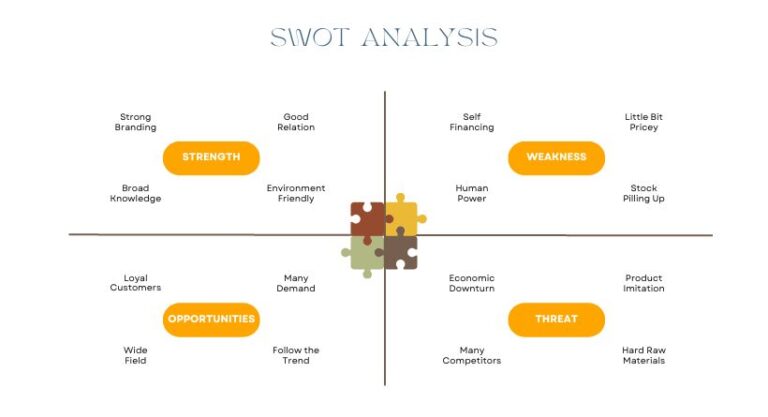Use a SWOT (strengths, weaknesses, opportunities, threats) analysis to grow your business.
- The four pillars of a SWOT analysis are strengths, weaknesses, opportunities, and threats for your business.
- A SWOT analysis’ main goal is to assist enterprises in fully understanding all the variables that go into choosing a course of action.
- Before you decide to take any corporate action, whether you are investigating new projects, updating internal policies, assessing possibilities to pivot, or changing a plan midway through its implementation, do a SWOT analysis.
- With a focus on utilizing strengths and chances to overcome weaknesses and threats, use your SWOT analysis to find suggestions and methods.
You should frequently assess your processes to make sure you are working as effectively as possible if you want to operate a profitable firm. While there are many ways to evaluate your business, one of the best approaches is to perform a SWOT analysis.
An examination of your company’s strengths, weaknesses, opportunities, and threats, or SWOT, is a planning procedure that aids in overcoming obstacles and identifying potential new business prospects.
A SWOT analysis’ main goal is to assist enterprises in fully understanding all the variables that go into choosing a course of action. During research to determine the reasons why business planning repeatedly failed, Albert Humphrey of the Stanford Research Institute developed this strategy in the 1960s. Since its inception, SWOT analysis has emerged as one of the most effective tools for company owners to launch and expand their enterprises.
According to Bonnie Taylor, chief marketing strategist of CCS Innovations, “it is hard to effectively map out a small business’s future without first examining it from all perspectives, which involves an extensive look at all internal and external resources and risks.” A SWOT analysis does this in four simple phases that even inexperienced business leaders may comprehend and use.
When should you perform a SWOT analysis?
A SWOT analysis may be used before you decide to take any kind of firm action, whether you’re evaluating new projects, revising internal policies, looking at possibilities to pivot, or changing a plan in the middle of its implementation. Sometimes it seems sense to do a broad SWOT analysis to assess your company’s present environment and make any necessary operational improvements. The research can highlight the main areas in which your company is operating at its best as well as where processes require improvement.
Avoid thinking casually about your company’s operations in the hopes that they will all work together harmoniously. You may gain a complete view of your company by taking the time to create a comprehensive SWOT analysis. From there, you may figure out how to strengthen or get rid of your company’s deficiencies while maximizing its strengths.
A SWOT analysis should undoubtedly involve the firm owner, but it is frequently beneficial to incorporate other team members as well. Ask a range of team members for their opinions, and then discuss any contributions in an open forum. You will be able to assess your company effectively from all angles thanks to the team’s comprehensive knowledge.
Characteristics of a SWOT analysis
The four components of the acronym are the focus of a SWOT analysis, which enables businesses to pinpoint the factors impacting a strategy, action, or effort. Knowing these advantages and disadvantages can help businesses explain more clearly what aspects of a strategy need to be acknowledged.
When writing a SWOT analysis, people often make a table with four columns, listing each aspect that will have an influence side by side for comparison. Although they should correlate since opportunities and dangers are ultimately connected, strengths and weaknesses rarely match opportunities and threats described exactly.
According to Billy Bauer, managing director of Royce Leather, a company’s most significant problems might be revealed by combining external threats with internal deficiencies.
After you’ve identified your risks, you can decide whether it would be best to address the internal flaw by allocating company resources to address the issues, or to lessen the external threat by giving up on the threatened business area and dealing with it after you’ve strengthened your own, according to Bauer.
Internal factors
The terms “weaknesses” (W) and “strengths” (S) refer to internal elements, such as the knowledge and skills you have at your disposal.
Commonly regarded internal causes include the following:
- financial capacity (funding, sources of income and investment opportunities)
- Physical assets (location, facilities and equipment)
- people resources (employees, volunteers and target audiences)
- access to copyrights, patents, trademarks, and natural resources
- current methods (employee programs, department hierarchies and software systems – like CRM Software and Accounting Software)
External factors
Every business, organization, and person is influenced and affected by external pressures. It is crucial to observe and record each of these characteristics, regardless of whether they are tied to an opportunity (O) or a threat (T) directly or indirectly.
Typically, external influences are things that neither you nor your business can control. Examples include the following:
- commercial trends (new products, technology advancements and shifts in audience needs)
- monetary patterns (local, national and international financial trends)
- Funding (donations, legislative and other sources) (donations, legislature and other sources)
- Demographics
- relations with partners and suppliers
- Regulations in politics, the environment, and the economy
You must formulate suggestions and plans based on the findings after developing your SWOT framework and doing your SWOT analysis. According to Linda Pophal, president and CEO of the consulting business Strategic Communications, these strategies should be centered on utilizing advantages and strengths to combat threats and weaknesses.
However, only if the analysis has been properly performed in the first place, according to Pophal. “This is essentially the area of strategy creation where businesses have the chance to be most creative and where unique ideas may arise,” he added.
SWOT analysis example
A SWOT analysis was extensively contributed to by Bryan Weaver, a partner at Stonefield Construction Law. He offered a sample SWOT analysis template and example to Business News Daily, which was utilized in the firm’s decision to extend its practice to include dispute mediation services. The following was included in his SWOT analysis:
| STRENGTHS | WEAKNESSES |
|
A legal practice that specializes in construction with staff members who are also professionally educated in engineering and general contracting. Their knowledge provides a special advantage. Three staff makes it small enough to adjust and react rapidly. |
No one has ever participated in a formal mediation training program or served as a mediator. One employee has participated in mediations, but not as an impartial party. |
| OPPORTUNITIES | THREATS |
|
The majority of commercial construction agreements need mediation. Only a handful of the many intermediaries on the market actually have building experience. The Stonefield staff may provide anyone with the benefit of a group of neutrals to examine a conflict. For minor disputes, mediators don’t act as a team, merely as individuals. |
Other construction law firms could start their own mediation services as anybody can become a mediator. The majority of prospective clients have a negative perception of mediation because they believe that mediators hurry to resolve conflicts without taking the time to fully comprehend them. |
The resulting plan is to enroll in mediation classes to overcome deficiencies and start Stonefield Mediation, which leverages the law firm’s brand recognition and emphasizes how the firm’s expertise in building and construction law sets it apart.
Weaver remarked, “Our SWOT analysis required us to deliberately and unbiasedly look at what we had and what the marketplace was delivering.” We then carefully created our business strategy to highlight the benefits of our best qualities while seizing chances based on industry deficiencies.
Additional business analysis strategies
The SWOT analysis is a straightforward yet thorough method for evaluating an action plan’s strengths and opportunities in addition to its weaknesses and threats. But a SWOT analysis is only one tool you may use to execute your business plan. PEST analysis (political, economic, social, and technical), MOST analysis (mission, objective, strategies, and tactics), and SCRS analysis are further analytical techniques to take into account (strategy, current state, requirements and solution).
The greatest approach to monitor development, strengths, and weaknesses is through regular business analysis and strategic planning. To evaluate and implement plans in a more thorough, balanced manner, use a number of analytical techniques like SWOT analysis in your decision-making process.







